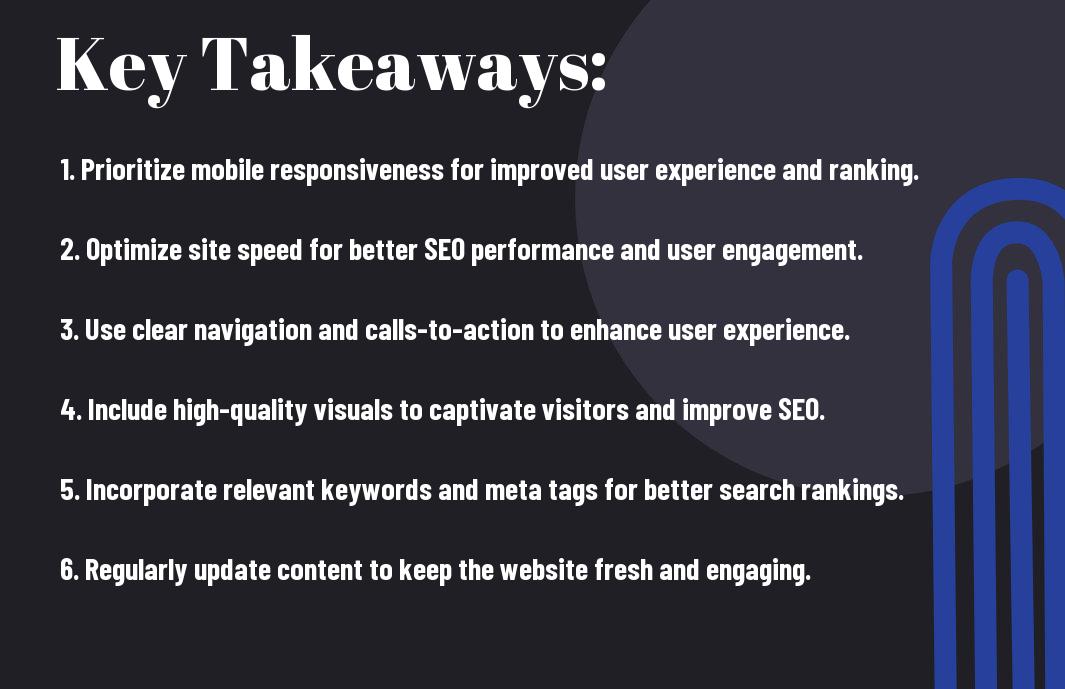Redesigning Your Website – Top Strategies For A Fresh And SEO-Friendly Look

Boost Your Online Presence With Professional Website Design Services
March 14, 2024
How To Choose The Right Website Design Company For Your Online Portfolio
March 18, 2024You’re ready to take your website to the next level with a fresh new look, but where do you start? Redesigning your website is not just about aesthetics; it’s also crucial for SEO purposes. A poorly executed redesign can lead to a drop in search engine rankings and organic traffic. In this blog post, we will discuss top strategies to ensure that your website makeover is not only visually appealing but also SEO-friendly. From optimizing site structure to improving page loading speed, we’ll cover all the crucial steps to help you achieve a successful website redesign that attracts both users and search engines.
Key Takeaways:
- Optimize for SEO: Ensure your website redesign focuses on SEO best practices to improve search engine visibility and rankings.
- Mobile Responsiveness: Prioritize a mobile-friendly design to enhance user experience and to comply with Google’s mobile-first indexing.
- Streamlined User Experience: Simplify navigation, improve site speed, and declutter your design to create a more user-friendly experience for visitors.

Understanding the Importance of Website Redesign
For more insights on why website redesigns can impact your SEO, take a look at this Website Redesign SEO Checklist: Tips to Avoid Big Drops. It’s crucial to understand the significance of redesigning your website not just for aesthetic reasons, but also for enhancing user experience and maintaining a competitive edge in the digital landscape.
The Impact of Design on User Experience
Redesign – The design of your website plays a critical role in shaping the overall user experience. A well-thought-out design can lead to improved navigation, faster load times, and increased engagement. On the other hand, a poorly designed website can frustrate visitors, leading to high bounce rates and decreased conversion rates.
Benefits of Regular Website Updates
Website – Regular website updates are important for staying relevant in the ever-evolving digital landscape. By keeping your site fresh with new content, features, and design elements, you not only improve user experience but also signal to search engines that your site is active and up-to-date. This can positively impact your search rankings and overall online visibility.
Understanding – Ignoring regular website updates can have detrimental effects on your online presence. Outdated content and design can make your site appear unprofessional and irrelevant to users, leading to a loss of credibility and potential customers. By consistently updating your website, you demonstrate your commitment to providing valuable and timely information to your audience, which can help you attract and retain customers in the long run.

Planning Your Redesign Strategy
Setting Clear Goals and Objectives
Even before plunging into the redesign process, it is crucial to establish clear goals and objectives. Define what you want to achieve with the redesign – whether it’s increasing website traffic, improving user experience, or boosting conversions. Setting clear goals will guide the entire redesign process and ensure that you stay focused on what matters most to your business.
Analyzing Current Website Performance
Even a visually stunning website won’t be effective if it doesn’t perform well. Analyze your current website’s performance by looking at metrics like bounce rate, page load speed, and conversion rates. This will give you valuable insights into what is working and what needs improvement. Identifying weak spots in your current website will help you strategize and prioritize the changes needed in the redesign.
Clear understanding of your current website’s performance is imperative to inform your redesign strategy. Look into metrics such as organic traffic sources, popular landing pages, and user engagement to pinpoint areas that require improvement. By analyzing current performance, you can identify key areas of focus for your redesign, ensuring a more impactful and successful outcome.
Key Elements of a Successful Website Redesign
Mobile Responsiveness and Cross-Platform Compatibility
Not having a mobile-responsive website can be detrimental to your online presence. Any successful website redesign should prioritize mobile responsiveness and cross-platform compatibility to ensure a seamless user experience across all devices. With the increasing number of users accessing websites on mobile devices, it is crucial to adapt your site for various screen sizes and resolutions.
User-Centric Design Principles
User-centric design principles should guide the redesign process to create a website that prioritizes the user experience. UserCentric considerations such as intuitive navigation, clear calls-to-action, and visually appealing design elements can enhance user engagement and satisfaction.
Incorporating On-Page SEO Best Practices
Redesigning your website presents an opportunity to improve its search engine optimization (SEO) performance. Plus, incorporating on-page SEO best practices such as optimizing meta tags, using relevant keywords, and creating high-quality content can help boost your site’s visibility in search engine results.
Optimizing Site Architecture for Search Engines
Architecture plays a crucial role in how search engines crawl and index your website. Incorporating a well-structured site architecture that includes clear hierarchy, strategic internal linking, and easy navigation can improve the overall SEO performance and user experience.

Implementing and Monitoring Your Redesign
Staging and Testing the Redesigned Website
Unlike the initial design phase, implementing and monitoring your website redesign is a crucial step in ensuring its success. Staging and testing the redesigned website before its launch is crucial to identify any potential issues and make necessary adjustments. This phase allows you to check for functionality, responsiveness, and overall user experience to guarantee a seamless transition for your visitors.
Tracking Performance and User Engagement
Redesigning your website is just the first step towards improving your online presence. Once the redesigned website is live, tracking performance and user engagement becomes paramount. Staging effective tools and analytics in place will enable you to monitor the performance of your new design, analyze user behavior, and make data-driven decisions to enhance the overall user experience.
Website performance should be closely monitored, including page load times, bounce rates, and conversion rates. Collecting and analyzing data on user engagement through heatmaps, click-through rates, and user interactions will provide valuable insights to optimize the design and content further. By staying informed on how visitors interact with the website, you can continuously refine and improve the overall user experience for better results.

To wrap up
Now you have a comprehensive guide on how to redesign your website for a fresh and SEO-friendly look. By implementing strategies such as optimizing for mobile, improving site speed, enhancing user experience, updating content, and leveraging SEO best practices, you can ensure that your website not only looks modern and attractive but also performs well in search engine rankings. Remember that a well-designed website is vital for attracting and retaining visitors, so make sure to stay updated on the latest trends and techniques in web design and SEO. By following these top strategies, you can give your website the makeover it deserves and drive your online presence to new heights.
FAQ
Q: Why is it important to redesign your website?
A: Redesigning your website is important to maintain a fresh and modern look, improve user experience, and stay competitive in the online market.
Q: How can a website redesign improve SEO?
A: A website redesign can improve SEO by implementing responsive design, optimizing page speed, updating content with relevant keywords, and enhancing user engagement.
Q: What are some key strategies for a successful website redesign?
A: Key strategies for a successful website redesign include setting clear goals, conducting thorough research and planning, prioritizing mobile responsiveness, simplifying navigation, and testing website performance.
Q: How often should a website be redesigned?
A: The frequency of website redesigns varies depending on industry trends, technological advancements, and changes in user behavior, but a redesign every 2-3 years is generally recommended to keep your website fresh and up-to-date.
Q: What are some common mistakes to avoid during a website redesign?
A: Common mistakes to avoid during a website redesign include neglecting mobile optimization, overlooking SEO best practices, making drastic design changes that confuse users, ignoring website security, and failing to backup the website before making major updates.


